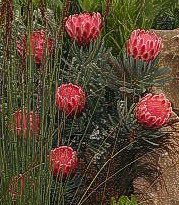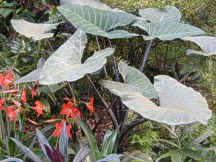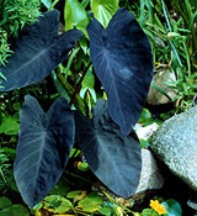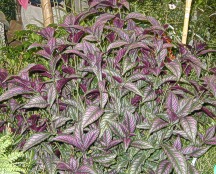
Dark & Sultry in the Summer Garden
Sally Ferguson
Basic black has long been a fashion staple. Now, black pants are joined in fashion by black plants as a dark trend takes hold in the garden.
For many trend-trackers the emergence of black as a foliage statement
probably began a decade ago with the introduction of dark-leaved coral
bells (Heuchera ‘Palace Purple’). A flurry of purply heucheras
followed, creating greater interest in dark foliage. People clamored for
more. Along came new bronze- and black-leaved cannas, ornamental grasses,
and coleuses.
Another stir occurred with the recent introduction of Colocasia esculenta ‘Black Magic’, an elephant ear plant with pitch-black leaves of enormous proportions. But it was probably little Ipomoea batatas ‘Blackie’, the dark-leaved, decorative sweet potato vine, whose arrival turned American gardeners’ growing interest in black foliage into a national groundswell. ‘Blackie’s introduction a few years back – seen first by trend-spotting sources in New York City’s plant district, gardening magazines and TV shows and botanic gardens coast-to-coast – swung a spotlight onto the dark appeal of ebony plants in the garden. Across America, the “black light” clicked on – and has stayed on ever since.
Design Aspects: Black Foliage in the Garden
Black foliage is best viewed up close as an accent plant or a design foil for highlighting other colors in the garden. For best effect, plant swaths of black to create blocks of color – one or two small plants alone will have limited impact. Ideally, position dark broad-leafed plants where sunlight can dance across and light them from behind.
|
For an elegant effect, mix dark leaves or flowers with soft pastel
colors such as apricot, pink, lavender, cream or pale yellow. For
a more raucous outcome, use blacks to rein in the heated contrasts
of exuberant yellows, reds, chartreuse, orange and orchid. Shocking
shades are nicely balanced by a judicious dose of black and purple. |
 |
| Xanthosoma violacea. An elephant ear |
Plant List of Not So Basic Blacks
This spring black foliage plants are featured as “cover girls” by a number of American mail-order garden catalogues. Among the dark superstars are Canna ‘Red Wine’ with vivid red flowers atop coal black stems and leaves, Elephant Ear ‘Black Magic’ with black leaves that unfurl to a length of two feet each, and Persian Shield with its striking striped dark purple foliage.
With interest increasing, new cultivars of black-leafed perennials, bulb flowers, annuals and even trees are introduced each season. But not all dark leaved plants are new introductions. Many are longtime favorites or ignored classics reincarnated.
Following is a list of excellent choices for fashionably black foliage from the Netherlands Flower Bulb Information Center in New York City. All are widely available through garden centers or mail-order garden sources either as bulbs or bare root plants, or pre-grown in nursery pots.
Canna ‘Black Knight’ – Cannas are tall, upright tropical-looking plants with broad elongated leaves. Their height and dramatic bearing make them indispensable as structural elements in borders and containers and in plantings designed as screening. At four feet high, ‘Black Knight’ is a medium-sized canna with black and green leaves and garnet red flowers. Available as bulbs for planting.
Canna ‘Red Wine’ – With its broad dark-burgundy foliage and deep red blooms, this dwarf canna (two to three feet tall) makes a fabulous foil for brighter plantings. Use short stocky ‘Red Wine’ for a dense shadowy effect in the lower reaches of container plantings or garden borders.
Similarly effective are the bronze and burgundy-leaved members of the Futurity Series of cannas: Canna ‘Red Futurity’ and ‘Rose Futurity’. All are available as bulbs.
Coleus ‘Inky Fingers’ – In the early ’70s, coleus (Solenostemon scutellaroides) was “houseplant du jour” for youthful “Baby Boomers.” Now, more than a quarter century later, the popular foliage plant has resurfaced with exotic new colorations to suit the times. Today’s gardeners enthuse over black-leafed ‘Inky Fingers’ plus dozens of other new coleus varieties in shades of green, black, burgundy, chartreuse, fuchsia, pewter, copper, amber, apricot and other colors.
Coral Bells ‘Bressingham Bronze’ – This low-growing, shade-loving perennial is best known for its foliage, earning its common name from its leafless stems of colorful bell-shaped florets. The dark shiny leaves of Heuchera ‘Bressingham Bronze’ make it a champ among black foliage plants in the garden. Other best bets among dark-leaved heuchera: ‘Palace Purple’, ‘Amethyst Mist’, ‘Pewter Moon', ‘Pewter Veil’, ‘Whirlwind', and ‘Chocolate Veil’.
Dahlia ‘Bishop of Llandaff’ – For sheer flower power in the summer garden or in the vase, it’s hard to beat dahlias. A garden prize known for its dark mahogany foliage and garnet-red flowers, ‘Bishop of Llandaff’ is a wonderful dahlia with a vocal fan club. Available as bulbs or in nursery pots.
Dahlia ‘Fascination’ – ‘Fascination’ is another superstar with glorious dark foliage. At 18- to 24-inches tall, this admirable dahlia has lilac semi-double flowers with yellow stamens. Available as bulbs or in nursery pots.
| Elephant Ear ‘Black Magic’ (aka ‘Jet Black Wonder’) | |
 |
This elephant ear is officially known as Colocasia esculenta, and it’s easy to see how this five-foot tall tropical foliage plant came by its nickname. With matte-black, two-foot long leaves shaped exactly like you-know-what, this elephant ear cultivar that travels under two different names lends an air of mystery to any setting. Available as bulbs or in nursery pots. |
Elephant Ear ‘Illustris’ – Another Colocasia esculenta bulb plant with dramatic dark foliage, C. esculenta ‘Illustris’ is a 30-inch tall plant with heart-shaped, 18-inch leaves of grey-black highlighted with lime green veins and edges. Grow from the bulb or buy in nursery pots at garden centers.
Oxalis regnelli var. triangularis – A charming, low-growing mound of three- or four-leafed “clovers,” this oxalis variety has deep, dark burgundy leaves and soft pink flowers. Its close relation O. regnelli var. triangularis ‘Mijke’ looks pretty much the same but with leaves that are even darker. Available as bulbs or in nursery pots.
| Persian Shield – Persian Shield (Strobilanthes dyerianus) has unusual glossy pointed dark leaves with colorful veining. | |
| The result is foliage that shimmers like miniature stained glass panels of maroon, blue and violet. The 28-inch tall plant is excellent in container combinations or in the garden. |  |
Purple Fountain Grass – Tall decorative grasses have become garden staples providing design possibilities galore. Purple fountain grass forms clumps of deep purple foliage topped by fluffy light-catching grass-heads. Watch for Pennisetum setaceum ‘Atropurpureum’ and Pennisetum setaceum ‘Rubrum’.
Red Japanese Maple – Officially Acer palmatum ‘Atropurpureum’, this magnificent small tree with a full shape is known for its colorful foliage: dark maroon in spring and summer, brilliant crimson in the fall.
Sweet Potato Vine ‘Blackie’ – Perfect for container plantings or in the garden, Ipomoea batatas ‘Blackie’ is a tender vine that provides a cascade of deeply notched ebony leaves, often growing five feet or more in a season. Good for shade or sun, ‘Blackie’ is an exuberant plant companion that complements most any other color planting.
| Purple Queen – Tradescantia pallida ‘Purple Queen’ is a classy dark foliage plant with small, odd, pink flowers. | |
 |
Watch how it spreads, growing rapidly in a horizontal vine-like manner, often rooting where it goes, with its slightly-furled, slightly-furry purple leaves extended like frantic fingers. This sun-lover thrives in the summer garden either in the ground or in a pot. Keep it over-winter as a potted plant in harsher climates. |
This article was provided by the Netherlands Flower Bulb Information Center. Visit their excellent site with a trove of information at www.bulb.com
Back to Table of Contents